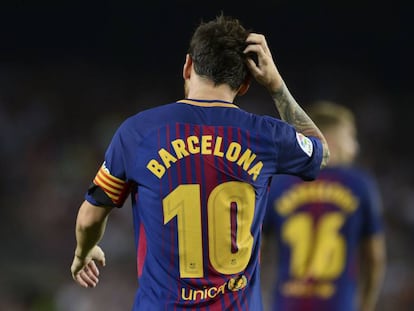Can David Villa make the difference for Spain against Italy?
After a three-year absence, La Roja’s top goal scorer returns in bid to create play in midfield

For months now, Spain’s national team has been pondering a solution to the brick wall its midfielders and playmakers seem to keep hitting every time they break into the opposing half in search of a way to push the ball into a position that could create a goal.
As often as not, the presence of Diego Costa, considered one of the best number nines in the business, has turned out to be a road block for La Roja, rather than a route toward the team’s opposing goal.
Play the ball centrally: that is the best way to beat Italy Paco Flores, coach of Zaragoza
Andrés Iniesta has gone so far as to say that despite the undoubted talent of Spain’s number nines over the years, he was reminded of the problems his former team, Barcelona, faced when they tried attacking with Ibrahamovic: in other words, Spain’s problem is collective. Torres, Llorente, Soldado, Negredo, Costa and Morata suffered from the collateral effect of a style of play that suffocated every midfielder except one.
The exception was always David Villa, La Roja’s record scorer, who is back after a three-year absence for the upcoming World Cup qualifiers. What set Villa apart was his ability to shake off his markers and distribute play in the center of the pitch.
The 35-year-old, who has been captain of New York City FC since 2014, has been recalled to coach Julen Lopetegui’s selection for matches against Italy and Liechtenstein, having failed to play for his country since the final match of their Brazil 2014 campaign, which ended in the group stages.
Pepe Acebal, who as coach of Sporting Gijón, promoted Villa to the team’s first team, has no doubts that Spain needs Villa. “Spain, because of its style of play, tends to occupy its opponents’ half of the pitch, needs a playmaker that can create opportunities for its midfielders, somebody who can move easily in small areas close to the goal and pass the ball. Villa was the best in the world at this.”
Villa’s gift is his combination of playmaking and shaking off defenders Pepe Acebal, coach of Sporting Gijón
When Julen Lopetegui took over as coach of the national team last year, he began searching for players that could dominate Spain’s rivals by keeping control of the ball, eventually settling on Diego Costa and Álvaro Morata.
It is not easy to assess Morata’s performance, given that he has barely played in the World Cup qualifiers so far. Costa played whenever he was fit, and while he managed five goals in five matches, he never seemed to fit in.
Lopetegui began looking for a solution earlier this year. He traveled to the United States to watch New York City FC. Villa has adapted well to Major League Soccer, but there were doubts as to whether Spain’s all-time leading goal scorer still has the form that helped the national team win the 2010 World Cup.
Lopetegui hasn’t brought Villa back to play in Saturday’s crucial second-leg qualifier against Italy in Madrid for his goal-scoring abilities per se: Spain has notched up 21 goals in six matches, all of them, with the exception of Italy, against inferior rivals. But Saturday’s game in the Santiago Bernabéu stadium is different: the teams are tied for the Group G lead after six matches. Only the group winner automatically qualifies. The runner-up will have to go through a playoff. Italy has not lost in its previous 56 qualifying matches. Nerves of steel are called for.
Paco Flores, who coached Villa at Zaragoza, has no doubts that Villa’s skills will be needed on Saturday. “In my opinion, if you use a tall, strong number nine, you are subtly inviting your players to play the ball centrally,” he says. “That is the best way to beat Italy. The Italians are masters at defending against attacks up front. They need to be attacked on the inside and using strikers that can pass in this way. Iago Aspas knows how to do this, but he only uses his left foot and that limits him if he needs to finish with his right; Villa can use either foot.”
“Villa is an amazing playmaker,” says Paco Flores, who believes that the number nines need to be tall and powerful. “People question his height because they don’t know about his big secret, which is playmaking. He is in his element in midfield, he takes control of the ball and shakes off his mark, leaving him behind. He’s a natural,” he adds.
Acebal concurs: “Villa’s gift is his combination of playmaking and shaking off defenders. Few goal scorers are able to get past the defense to receive the ball without being caught offside. It requires split-second timing and he does it so well and so often. A lot of players know how to shake off the man marking them, but few are able to do it throughout the match. He enjoys it, you can see it. Some strikers look like they are wearing a backpack. Villa is so Slim because this makes it easier to slip past his marker better than anybody else.”
Fans remember David Villa for his skills with the ball. His colleagues revere him for what he does before receiving it, which is quite simply opening the door to play and the opposing team’s goal.
English version by Nick Lyne.
Tu suscripción se está usando en otro dispositivo
¿Quieres añadir otro usuario a tu suscripción?
Si continúas leyendo en este dispositivo, no se podrá leer en el otro.
FlechaTu suscripción se está usando en otro dispositivo y solo puedes acceder a EL PAÍS desde un dispositivo a la vez.
Si quieres compartir tu cuenta, cambia tu suscripción a la modalidad Premium, así podrás añadir otro usuario. Cada uno accederá con su propia cuenta de email, lo que os permitirá personalizar vuestra experiencia en EL PAÍS.
¿Tienes una suscripción de empresa? Accede aquí para contratar más cuentas.
En el caso de no saber quién está usando tu cuenta, te recomendamos cambiar tu contraseña aquí.
Si decides continuar compartiendo tu cuenta, este mensaje se mostrará en tu dispositivo y en el de la otra persona que está usando tu cuenta de forma indefinida, afectando a tu experiencia de lectura. Puedes consultar aquí los términos y condiciones de la suscripción digital.











































